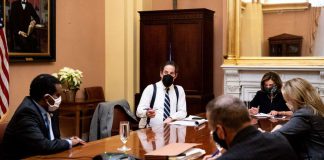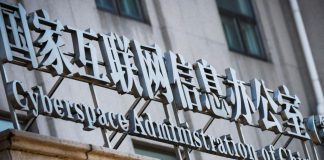JUNE 21, 2022
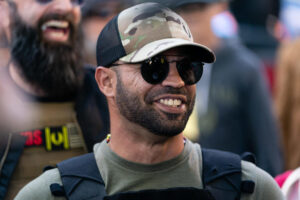
Enrique Tarrio, leader of the Proud Boys, a far-right group, attends a “Stop the Steal” rally against the results of the U.S. presidential election outside the Georgia state Capitol on Nov. 18, 2020, in Atlanta. – Elijah Nouvelage/Getty Images
Fresh out of jail after burning a Black Lives Matter flag at a Stop the Steal protest in Washington, D.C., Proud Boys Chairman leader Henry “Enrique” Tarrio stood in a dark parking garage wearing hunting fatigues and reached out his hand.
“I’m Stewart, pleasure,” Oath Keepers founder Stewart Rhodes said in his Montana cattle rancher hat, reaching out his arm to shake hands with Tarrio.
“Stewart, pleasure is all mine,” Tarrio responded.
It was Jan. 5, 2021, the night before the assault on the Capitol. Their introduction appeared to indicate a first-time meeting, but court documents say the conversation lasted for 30 minutes and the word “Capitol” was mentioned.
The video clip of the exchange – aired at the opening hearing of the House Select Committee investigating the Jan. 6 insurrection – is part of a bigger trove of evidence about the alleged role of the Proud Boys and the Oath Keepers attack on the U.S. Capitol.
Justice Department prosecutors have laid out much of the same information in their own separate investigations charging leaders of both groups with seditious conspiracy — the most serious charges to date related to Jan. 6. But the House committee has interviewed hundreds of witnesses and key participants and dropped tantalizing hints about information it has uncovered.
The most incendiary from the committee centers on alleged involvement by former President Donald Trump or his associates in setting a mob loose on the Capitol to illegally try to keep him in office. The committee’s chairman has gone further, hinting that the investigation has tied people close to Trump to alleged plots by the Proud Boys and Oath Keepers, to lead a violent effort to prevent the orderly transfer of power to President-elect Joe Biden.
After the committee aired video footage of the two groups’ leaders Jan. 5 meeting in the garage, a CNN anchor asked the chairman, Rep. Bennie Thompson, D-Miss., if the committee has “witnesses that describe actual conversations between these extremist groups and anyone in Trump’s orbit?”
“Yes. Obviously, you’ll have to go through the hearings,” which will be held throughout June, Thompson replied. “But we have a number of witnesses who have come forward that people have not talked to before, that will document a lot of what was going on in the Trump orbit while all of this was occurring.”
The committee, has no power to bring criminal charges against people for their suspected role in the Jan. 6 attack. The Justice Department does, and has brought charges against more than 800 people.
On Thursday, tensions between those overseeing the two parallel investigations erupted into public view when Justice renewed its request for the House committee’s transcripts of hundreds of witness interviews conducted during its yearlong investigation. The transcripts are “not just potentially relevant to our overall criminal investigations but are likely relevant to specific prosecutions that have already commenced,” prosecutors said in court filings related to its case against the Proud Boys and their former leader, Tarrio.
Initially, the committee declined, saying it wanted to finish its investigation first. It has also said that the Justice Department has uncovered a lot of information that it has not publicly released or shared.
On Saturday, a committee spokesman told USA TODAY that it is now engaged in “a cooperative process” with the Justice Department. “We believe accountability is important and won’t be an obstacle to the department’s prosecutions,” said spokesman Tim Mulvey. He said the committee would not provide details of that cooperation publicly.
Meanwhile, representatives of the Proud Boys and Oath Keepers say the garage meeting between Tarrio and Rhodes was a chance encounter. Committee members have not laid out specifics about their view of the significance of it – or how it may involve people connected to Trump. A committee official told USA TODAY that the two organizations will be covered in upcoming hearings.
Who are the Proud Boys and Oath Keepers?
The Proud Boys, founded in 2016, have become one of the most visible of the American far-right organizations promoting white supremacist and racist rhetoric. The Oath Keepers, founded in 2009, are an antigovernment paramilitary group that heavily recruits former members of the military and law enforcement.
Both groups have become known for their patrols of communities while claiming to protect citizens and local business owners from left-wing antifa protesters. Each increased in popularity – and controversy – during the administration of Donald Trump.
The Proud Boys soared to prominence in 2020 when, instead of disavowing the group during a presidential debate, he said, “Proud Boys – stand back and stand by.” Membership in the Proud Boys tripled in the wake of that statement, according to testimony in front of the committee.
What were their roles in Jan. 6?
According to the House committee, both groups began planning for Jan. 6 weeks in advance, and played separate and distinct roles in the Capitol attack.
A documentary filmmaker, testifying at the first committee hearing on June 9, said several hundred Proud Boys left a morning rally at the Ellipse Jan. 6 and headed for the Capitol long before Trump began speaking and urged his supporters to do so.
Video footage aired at the hearing showed that Proud Boys members instigated the first breach of the Capitol just before 1:00 p.m., when rioters pushed over barricades and overran a small Capitol Police force trying to block them. Trump’s speech, which took place a 20-minute walk from the Capitol, did not finish until 1:10 p.m.
“The attack on our Capitol was not a spontaneous riot,” committee Vice Chair Liz Cheney, R-Wyo., said. She added that intelligence available before Jan. 6 identified plans to “invade the Capitol, occupy the Capitol, and take other steps to halt Congress’s count of electoral votes that day.”
According to Cheney and other committee members, the Oath Keepers began planning to block the peaceful transfer of power shortly after the Nov. 3, 2020 election, when Rhodes, the group’s leader, told his followers that, “we were not going to get through this without a civil war.”
On Jan. 6, columns of Oath Keepers — wearing helmets, reinforced vests and military-style insignia — moved through the mob of protesters on the Capitol steps in two consecutive military-style “stack formations,” and went looking for House Speaker Nancy Pelosi.
Barbara McQuade, a veteran federal prosecutor from Michigan, said she previously thought Trump was a beneficiary of a mostly spontaneous insurrection, not a planner, until she watched the three hearings to date.
“I thought that he certainly riled up people, but that he was probably as surprised as anybody that they actually got through the door,” McQuade said of the rioters. “Now I’m not so sure.”
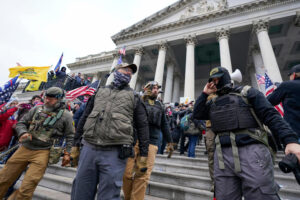
Members of the Oath Keepers on the East Front of the U.S. Capitol on Jan. 6, 2021, in Washington. The District of Columbia has filed a civil lawsuit seeking harsh financial penalties against far-right groups Proud Boys and Oath Keepers over their role in the Jan. 6 attack on the Capitol by supporters of former President Donald Trump. – Manuel Balce Ceneta, AP
Rhodes did not enter the Capitol, instead giving orders over the radio while outside the building. Other heavily armed Oath Keepers stayed in a hotel in Arlington, Virginia to serve as quick reaction forces, according to the committee and the Justice Department. They were on standby in case Trump initiated the Insurrection Act.
Later, as the attack unfolded, Tarrio took credit for the Capitol assault, saying in an encrypted chat that “make no mistake” and “we did this,” according to Justice Department documents.
What is seditious conspiracy and who has been charged with it?
In its sprawling investigation, the Justice Department has leveled what are by far its most serious charges, of seditious conspiracy, against the leaders of the Proud Boys and Oath Keepers.
According to federal law, a seditious conspiracy occurs when two or more persons “conspire to overthrow, put down, or to destroy by force the Government of the United States, or to levy war against” it.
Seditious conspiracy can also occur when co-conspirators oppose by force the authority of the government, or use force to prevent, hinder, or delay the execution of any law of the United States.
Prosecutors – and members of the Select Committee – have said the charges stem from their belief that the two groups’ participation in the Jan. 6 attack amounted to an organized assault on democracy and an intentional attempt to prevent the peaceful transfer of presidential power.
Rhodes, a former Army paratrooper and Yale Law School graduate, was indicted first, last January, along with at least 10 other Oath Keepers.
“Rhodes and certain co-conspirators, to include selected regional leaders, planned to stop the lawful transfer of presidential power by Jan. 20, 2021, which included multiple ways to deploy force,” the indictment said. “They coordinated travel across the country to enter Washington, D.C., and equipped themselves with a variety of weapons, donned combat and tactical gear, and were prepared to answer Rhodes’s call to take up arms at Rhodes’s direction.”
Earlier this month, three days before the first Select Committee’s first hearing, DOJ unveiled similar seditious conspiracy charges against Tarrio, the Proud Boys’ former national chairman, and four top associates.
“On Jan. 6, 2021, the defendants directed, mobilized, and led members of the crowd onto the Capitol grounds and into the Capitol, leading to dismantling of metal barricades, destruction of property, breaching of the Capitol building, and assaults on law enforcement,” prosecutors said. “During and after the attack, Tarrio and his co-defendants claimed credit for what had happened on social media and in an encrypted chat room.”
Vance and other former top federal prosecutors told USA TODAY it’s extremely tough for the government to prove a seditious conspiracy case. But, they noted, the Justice Department already has flipped at least two key witnesses, including Oath Keeper Joshua James, and gotten them to cooperate in the ongoing investigation.
Cheney said the committee plans to devote one or possibly two full hearings to the role played by both groups before and during the Jan. 6 assault.
What has the Jan. 6 committee said about Proud Boys, Oath Keepers, and Trump’s orbit?
In its opening hearing, the committee aired footage of the meeting between Tarrio and Rhodes in a garage. Also present was Bianca Gracia, the founder and director of the Latinos for Trump organization, and Kellye SoRelle, a family lawyer from Texas, who took over as head of the Oath Keepers after Rhodes’ arrest in January 2022.
Representatives of both groups – rivals that are often at odds with each other – have said the meeting was coincidental and did not constitute any kind of plotting. But investigators are interested in ties between both groups and Roger Stone, a longtime Trump operative and friend, according to two sources close to the committee and a lawyer for an Oath Keeper who is now cooperating with the government.
The Select Committee has also begun unveiling what it believes to be a compelling case linking Trump’s actions to those of the mob that attacked the Capitol.
“President Trump summoned the mob, assembled the mob, and lit the flame of this attack,” Cheney said. “You will also hear about plots to commit seditious conspiracy on Jan. 6, a crime defined in our laws as conspiring to overthrow, put down, or destroy by force the government of the United States or to oppose by force the authority thereof.”
“In our hearings to come, we will identify elements of those plans and we will show specifically how a group of Proud Boys led a mob into the Capitol building on Jan. 6,” Cheney said.
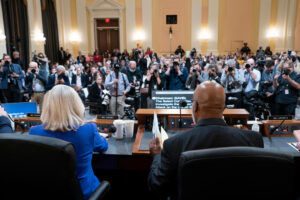
Vice Chair Liz Cheney, R-Wyo., and Chairman Bennie Thompson, D-Miss., lead the House committee investigating the Jan. 6 attack on the U.S. Capitol. – Pool photo by Alex Brandon
A moment later, she added, “As you hear this, all Americans should keep in mind this fact… Over multiple months, Donald Trump oversaw and coordinated a sophisticated seven-part plan to overturn the presidential election and prevent the transfer of presidential power.”
So far, neither the committee nor the Justice Department has presented any evidence tying Trump or any of his associates to the seditious conspiracy charges filed against the Proud Boys and Oath Keepers – or demonstrating that the two groups worked together.
Proud Boys and Oath Keepers provided private security for Stone or other right-wing figures who came to Washington for events surrounding the Jan. 6 protest. Stone, who has denied wrongdoing, was also the founder of the “Stop the Steal” movement that helped launch the Jan. 6 rally in the first place and was in touch with many Trump associates during that time, according to the two sources close to the committee.
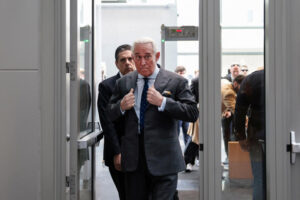
Roger Stone, a former adviser and confidante to former President Donald Trump, arrives to the Thomas P. O’Neill Jr. Federal Building for a deposition before the House Select Committee investigating the Jan. 6 Attack on the United States Capitol on December 17, 2021 in Washington, D.C. – Anna Moneymaker, Getty Images
James, who led the Oath Keepers’ Alabama chapter, pleaded guilty in March to seditious conspiracy charges and is cooperating with the Justice Department in its ongoing investigation.
Last November, the committee subpoenaed Stone as part of an effort to obtain information about who planned and financed pro-Trump rallies the evening of Jan. 5 and the morning of Jan. 6 – and the march to the Capitol afterward.
Stone had planned to attend Trump’s Jan. 6 rally but ultimately decided against it, saying he did not receive a VIP invitation, he told a documentary film crew in conversations reported by the Washington Post. Another documentary filmmaker later captured footage of him packing up and leaving Washington that evening.
Stone was in a hurry, he said on the footage, because he feared prosecution by Biden’s incoming attorney general, Merrick Garland. “He is not a friend,” Stone said.
In subpoenaing Stone, committee members also wanted to know “what communications organizers had with officials in the White House and Congress.”
Soon after, the committee subpoenaed the leaders of the Oath Keepers, Proud Boys and a third right-wing extremist group that provided security around Jan. 6, the 1st Amendment Praetorian and its chairman, Robert Patrick Lewis.
Committee members, so far, also have provided no details about who they might call as witnesses to show potential coordination between the two extremist groups – or between them and anyone in Trump’s orbit.
Vance and other former top federal prosecutors told USA TODAY that it would be potentially very damning for Trump – politically and legally – if the committee has gathered evidence of conversations between people close to him and rioters either before or during the assault on the Capitol.
It would be even more devastating for Trump, they said, if the committee has found any kind of advance discussions – or planning – between Trump or his supporters and members of the Oath Keepers or Proud Boys.
“Like everything with prosecutions, the devil is in the details,” said Vance, the former United States Attorney for the Northern District of Alabama. “You have to first see the evidence and then evaluate it.”









































































































